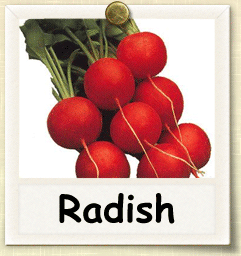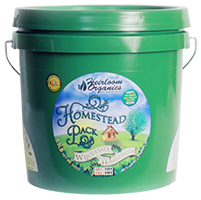|
Home > Guides > Vegetables > Radish |
|
How to Grow Radishes | Guide to Growing Radishes |
|
|
|
|
| |
 |
|
Overview |
|
|
|
|
|
| |
|
| |
Easy to grow and ready to harvest in just 3 to 6 weeks. Make plantings of cool-season spring radishes every week or two for a continuous harvest until hot weather hits. Don’t forget winter varieties that produce large, fall-harvested roots. |
|
| |
|
|
| |
Growing Guide
GROWING NOTES
Yields best in full sun.
Prefers well-drained, loose soil, high in organic matter, free from stones, with pH 5.8 to 6.8. Needs plentiful, consistent moisture.
A few winter radish varieties are biennials.
MAINTAINING
Grows best in cool (50 F to 65 F), moist weather. Hot weather reduces quality and increases pungency. Late plantings may bolt before edible root forms.
About 3 to 6 weeks before average last frost, direct seed ½ inch deep, 1 inch apart, in rows 12 inches apart. Thin to about 2-inch spacings. Crowded plants may not produce high-quality roots. Use thinings in salads.
For continuous harvest, make additional plantings every 1 to 2 weeks until temperatures average in the mid 60s F, or plant varieties with different maturity dates in a single planting. Resume planting when weather cools in fall.
Plant most winter varieties so that they mature around the first fall frost date. (Frost improves flavor and texture of most winter varieties.) Larger winter varieties need more space than spring varieties, so thin to about 6-inch spacings, depending on variety.
Keep soil moist for uninterrupted growth and best quality.
Adding nitrogen fertilizer or nitrogen rich manure close to planting may produce lush tops and small roots.
Can be sown in the same row with carrots, parsley, parsnips and other slow germinating crops. The radishes help to break soil crust for the weaker and later-germinating crops.
Because they mature quickly, radishes make a good intercrop along with slower growing crops, such as other cabbage family crops, or tomato- or squash family crops. Or follow radish harvest with summer succession crops such as beans, or fall-harvested crops.
To help reduce disease, do not plant radishes or other cole crops in the same location more than once every three or four years.
|
|
| |
|
| |
Heirloom seeds are the gardeners choice for seed-saving from year-to-year. Learning to save seeds is easy and fun with these books. Before you harvest, consider which varieties you might want to save seeds from so that your harvesting practice includes plants chosen for seed saving. Be sure to check out our newest seed packs, available now from Heirloom Organics. The Super Food Garden is the most nutrient dense garden you can build and everything you need is right here in one pack. The Genesis Garden s a very popular Bible Garden collection. The Three Sisters Garden was the first example of companion planting in Native American culture. See all of our brand-new seed pack offerings in our store.
|
|
| |
|
|
| |
Harvesting Guide
HARVESTING
The time from planting to harvest is 20 to 30 days for spring radishes, 50 to 60 days for winter radishes. Pull up the whole plant when the radishes are the right size
Cherry Belle, harvest at 22 days, is an All America Selection producing round, red, 3/4-inch roots.
White Icicle, harvest at 28 days, gives white, icicle-shaped roots that are 5 inches long.
French Breakfast, harvest at 23 days, is oblong and red with white on the bottom.
Summer Cross Hybrid, harvest at 45 days, is an Asian-type, all-season variety that gives white flesh.
Sparkler, harvest at 25 days, is still popular after 30 years.
SAVING SEEDS
Open pods by hand for small amounts of seed. Pods that do not open when rubbed between hands can be pounded with hammer or mallet. Winnow to remove remaining chaff. |
|
| |
|
|
|
| |
|
|
|
|
|
| You can find this variety in the following Seed Packs: |
|
  
  |
|
| Click the packs below to see some of our other wonderful products |
|
|
|
|
|
|
|